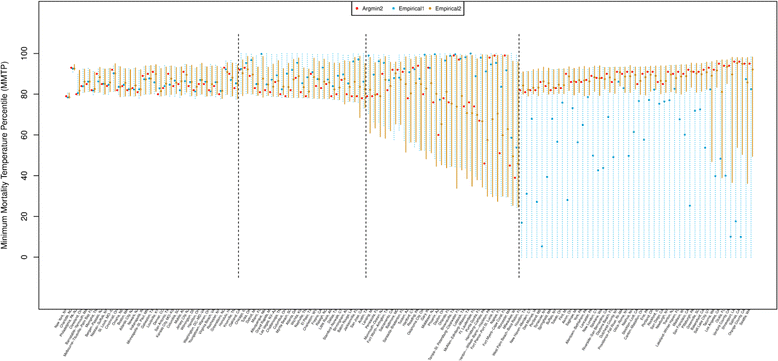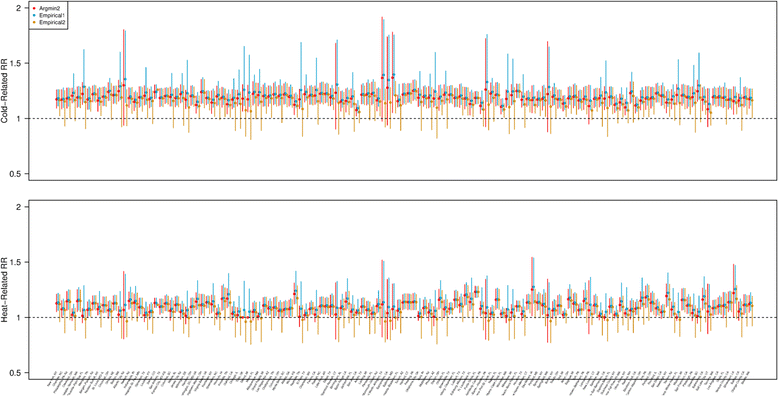Monte Carlo simulation-based estimation for the minimum mortality temperature in temperature-mortality association study
- PMID: 28882102
- PMCID: PMC5590173
- DOI: 10.1186/s12874-017-0412-7
Monte Carlo simulation-based estimation for the minimum mortality temperature in temperature-mortality association study
Abstract
Background: Rich literature has reported that there exists a nonlinear association between temperature and mortality. One important feature in the temperature-mortality association is the minimum mortality temperature (MMT). The commonly used approach for estimating the MMT is to determine the MMT as the temperature at which mortality is minimized in the estimated temperature-mortality association curve. Also, an approximate bootstrap approach was proposed to calculate the standard errors and the confidence interval for the MMT. However, the statistical properties of these methods were not fully studied.
Methods: Our research assessed the statistical properties of the previously proposed methods in various types of the temperature-mortality association. We also suggested an alternative approach to provide a point and an interval estimates for the MMT, which improve upon the previous approach if some prior knowledge is available on the MMT. We compare the previous and alternative methods through a simulation study and an application. In addition, as the MMT is often used as a reference temperature to calculate the cold- and heat-related relative risk (RR), we examined how the uncertainty in the MMT affects the estimation of the RRs.
Results: The previously proposed method of estimating the MMT as a point (indicated as Argmin2) may increase bias or mean squared error in some types of temperature-mortality association. The approximate bootstrap method to calculate the confidence interval (indicated as Empirical1) performs properly achieving near 95% coverage but the length can be unnecessarily extremely large in some types of the association. We showed that an alternative approach (indicated as Empirical2), which can be applied if some prior knowledge is available on the MMT, works better reducing the bias and the mean squared error in point estimation and achieving near 95% coverage while shortening the length of the interval estimates.
Conclusions: The Monte Carlo simulation-based approach to estimate the MMT either as a point or as an interval was shown to perform well particularly when some prior knowledge is incorporated to reduce the uncertainty. The MMT uncertainty also can affect the estimation for the MMT-referenced RR and ignoring the MMT uncertainty in the RR estimation may lead to invalid results with respect to the bias in point estimation and the coverage in interval estimation.
Keywords: Minimum mortality temperature; Monte Carlo simulation-based estimation; Point and interval estimation.
Conflict of interest statement
Ethics approval and consent to participate
Not applicable.
Consent for publication
Not applicable.
Competing interest
The authors declare that they have no competing interests.
Publisher’s Note
Springer Nature remains neutral with regard to jurisdictional claims in published maps and institutional affiliations.
Figures


Similar articles
-
Comparative assessment of parameter estimation methods in the presence of overdispersion: a simulation study.Math Biosci Eng. 2019 May 16;16(5):4299-4313. doi: 10.3934/mbe.2019214. Math Biosci Eng. 2019. PMID: 31499663
-
Parametric and nonparametric population methods: their comparative performance in analysing a clinical dataset and two Monte Carlo simulation studies.Clin Pharmacokinet. 2006;45(4):365-83. doi: 10.2165/00003088-200645040-00003. Clin Pharmacokinet. 2006. PMID: 16584284
-
A Monte Carlo maximum likelihood method for estimating uncertainty arising from shared errors in exposures in epidemiological studies of nuclear workers.Radiat Res. 2007 Dec;168(6):757-63. doi: 10.1667/RR0677.1. Radiat Res. 2007. PMID: 18088178
-
Methods to account for uncertainties in exposure assessment in studies of environmental exposures.Environ Health. 2019 Apr 8;18(1):31. doi: 10.1186/s12940-019-0468-4. Environ Health. 2019. PMID: 30961632 Free PMC article. Review.
-
Inference With Difference-in-Differences With a Small Number of Groups: A Review, Simulation Study, and Empirical Application Using SHARE Data.Med Care. 2018 Jan;56(1):97-105. doi: 10.1097/MLR.0000000000000830. Med Care. 2018. PMID: 29112050 Review.
Cited by
-
COVID-19 in South Korea: epidemiological and spatiotemporal patterns of the spread and the role of aggressive diagnostic tests in the early phase.Int J Epidemiol. 2020 Aug 1;49(4):1106-1116. doi: 10.1093/ije/dyaa119. Int J Epidemiol. 2020. PMID: 32754756 Free PMC article.
-
Suicide and Ambient Temperature: A Multi-Country Multi-City Study.Environ Health Perspect. 2019 Nov;127(11):117007. doi: 10.1289/EHP4898. Epub 2019 Nov 26. Environ Health Perspect. 2019. PMID: 31769300 Free PMC article.
-
Synergistic effect of periodontitis and C-reactive protein levels on mortality: NHANES 2001-2004.PLoS One. 2024 Oct 25;19(10):e0309476. doi: 10.1371/journal.pone.0309476. eCollection 2024. PLoS One. 2024. PMID: 39453923 Free PMC article.
-
Comparison of climatic factors on mosquito abundance at US Army Garrison Humphreys, Republic of Korea.PLoS One. 2020 Oct 21;15(10):e0240363. doi: 10.1371/journal.pone.0240363. eCollection 2020. PLoS One. 2020. PMID: 33085720 Free PMC article.
-
Changing Susceptibility to Non-Optimum Temperatures in Japan, 1972-2012: The Role of Climate, Demographic, and Socioeconomic Factors.Environ Health Perspect. 2018 May 2;126(5):057002. doi: 10.1289/EHP2546. Environ Health Perspect. 2018. PMID: 29727132 Free PMC article.
References
-
- Gasparrini A, Guo Y, Hashizume M, Lavigne E, Zanobetti A, Schwartz J, Tobias A, Tong S, Rocklöv J, Forsberg B. Mortality risk attributable to high and low ambient temperature: a multicountry observational study. Lancet. 2015;386(9991):369–375. doi: 10.1016/S0140-6736(14)62114-0. - DOI - PMC - PubMed
-
- Guo Y, Gasparrini A, Armstrong B, Li S, Tawatsupa B, Tobias A, Lavigne E, de Sousa Zanotti Stagliorio Coelho M, Leone M, Pan X, et al. Global variation in the effects of ambient temperature on mortality: a systematic evaluation. Epidemiology. 2014;25(6):781–789. doi: 10.1097/EDE.0000000000000165. - DOI - PMC - PubMed
MeSH terms
LinkOut - more resources
Full Text Sources
Other Literature Sources

